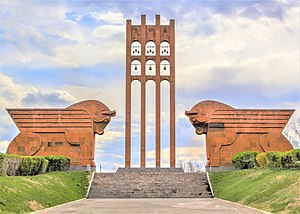
Back معركة سارداراباد Arabic ܩܪܒܐ ܣܪܕܐܪܐܒܕ ARC Sərdarabad döyüşü Azerbaijani سرداراباد دؤیوشو AZB Сардарапацкая бітва Byelorussian Сардарапацкая бітва BE-X-OLD Битка за Сардарапад Bulgarian Batalla de Sardarapat Catalan Schlacht von Sardarapat German Batalo de Sardarapat Esperanto
| Battle of Sardarabad | |||||||
|---|---|---|---|---|---|---|---|
| Part of the Caucasus campaign | |||||||
 The memorial dedicated to the Armenian victory at the battle of Sardarabad near Araks, Armavir, Armenia | |||||||
| |||||||
| Belligerents | |||||||
|
| ||||||
| Commanders and leaders | |||||||
|
(Commander of the Armenian Army Corps) (Commander of the Yerevan Detachment) Poghos Bek-Pirumyan |
Enver Pasha Wehib Pasha Kazim Pasha (Commander of the I Caucasian Corps)[2][3][4] Rüştü Bey (Commander of the 9th Caucasian Division)[5] Zihni Bey (Commander of the Zihni Bey Detachment)[3][4] | ||||||
| Strength | |||||||
| 9,000[n 1] |
30,000-33,000[n 2] Including Kurdish cavalry 1,500–3000 40 cannons | ||||||
| Casualties and losses | |||||||
| unknown | 5,500 dead alone from 22 to 26 May[6][7] | ||||||
The Battle of Sardarabad (Armenian: Սարդարապատի ճակատամարտ, romanized: Sardarapati chakatamart; Turkish: Serdarabad Muharebesi)[8] was a battle of the Caucasus campaign of World War I that took place near Sardarabad, Armenia, from 21 to 29 May 1918, between the regular Armenian military units and militia on one side and the Ottoman army that had invaded Eastern Armenia on the other. As Sardarabad is approximately 40 kilometres (25 mi) west of the capital of Yerevan, the battle not only halted the Ottoman advance into the rest of Armenia, but also prevented the complete destruction of the Armenian nation.[9][1] The battle paved the way for the establishment of the First Republic of Armenia[1]and the Treaty of Batum: recognition of Armenia by the Ottoman Empire.
In the words of Christopher J. Walker, had the Armenians lost this battle, "it is perfectly possible that the word Armenia would have henceforth denoted only an antique geographical term".[10]
- ^ a b c d Cite error: The named reference
Crossroadswas invoked but never defined (see the help page). - ^ T.C. Genelkurmay Harp Tarihi Başkanlığı Yayınları, Türk İstiklâl Harbine Katılan Tümen ve Daha Üst Kademelerdeki Komutanların Biyografileri, Genkurmay Başkanlığı Basımevi, Ankara, 1972, pp. 161–162. (in Turkish)
- ^ a b (in Turkish) Karabekir, Kâzım. Erzincan ve Erzurum'un Kurtuluşu: Sarıkamış, Kars ve Ötesi (The Liberation of Erzincan and Erzurum: Sarıkamış, Kars and Beyond). Erzurum Ticaret ve Sanayi Odası Araştırma, Geliştirme ve Yardımlaşma Vakfı, 1990, p. 377. ISBN 978-975-512-072-0.
- ^ a b (in Turkish) Gürbüz, Mustafa, "1917 Rus İhtilali Sonrası Kafkasya'da Türk Askeri Faaliyetleri: Serdarabad Savaşları ve Siyasi Sonuçları" [Turkish Military Operations in the Caucasus after the 1917 Russian Revolution: The battles of Serdarabad and its Political Results]. Ermeni Araştırmaları, No. 25, 2007.
- ^ T.C. Genelkurmay Harp Tarihi Başkanlığı Yayınları, Türk İstiklâl Harbine Katılan Tümen ve Daha Üst Kademelerdeki Komutanların Biyografileri, Genkurmay Başkanlığı Basımevi, Ankara, 1972, pp. 29–30. (in Turkish)
- ^ Cite error: The named reference
SAEwas invoked but never defined (see the help page). - ^ Galoyan, G.; Lazakhetsy, V. (2000). Հայաստանի Հանրապետությունը 1918-1920 թթ [The Republic of Armenia, 1918–1920] (PDF) (in Armenian). Yerevan: Publishing House "Science". p. 16. ISBN 5-8080-0436-5.
- ^ (in Turkish) Uras, Esat. Tarihte Ermeniler ve Ermeni Meselesi (The Armenians in History and the Armenian Question). Belge Yayınları, 1976, p. LXVII.
- ^ Balakian, Peter (2003). The Burning Tigris: The Armenian Genocide and America's Response. New York: HarperCollins. p. 321. ISBN 0-06-055870-9.
- ^ Walker, Christopher J. (1990). Armenia The Survival of a Nation, 2nd ed. New York: St. Martin's Press. pp. 254–255. ISBN 0-7099-0210-7.
Cite error: There are <ref group=n> tags on this page, but the references will not show without a {{reflist|group=n}} template (see the help page).
© MMXXIII Rich X Search. We shall prevail. All rights reserved. Rich X Search